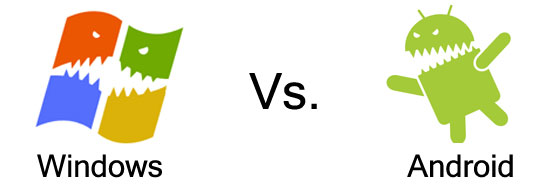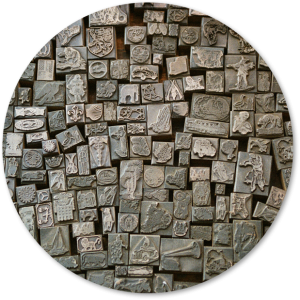Android is a scary platform

Significant Other is asking me in 12-hour intervals: “Which state are we in: Like, dislike, hate?” Kids are showing me handling best practice and useful apps. Any time and again you’d hear me cursing or smiling in joy – I’ve switched from a Windows Phone to Android!
Why? Well … 2 reasons, mainly: (1) my mobile provider doesn’t really support WP too well and (2) I wanted to know what Android is on to these days.
To begin with: I may have made a mistake by not choosing the Android-native Nexus; reason: I missed the SD card slot. Secondly, I stumbled across a review of OnePlus just a few days too late (that would’ve been interesting, too). So, eventually I ended up with a Samsung Galaxy S5 which after boot instantly updated to Lollipop (5.0) – without flaw.
Hardware
The device is a 2.5GHz/2GB hardware with 16GB of internal memory (I added my 16G SD card holding all Windows Phone data – no prob here, either). First impressions in short:
- solidly built hardware
- nice display
- very (very!) good camera with a lot of parameter possibilities (and HDR, of course)
- LTE (fast and stable enough)
- download booster combining WiFi and 4G for increased bandwidth (even faster, notably)
- and a ton of apps from the beginning
Major annoyance: Some really strange and not at all useful native Samsung Apps (yes, I was warned that I won’t like that – took me a bit to wipe or disable and exchange them by their Android-native relatives but in the end I was fine).
Customization
You know that typical Android look-and-feel, right?

Turns out that Samsung had of course added their own launcher (TouchWiz) deeply into the OS – it isn’t too bad a feature; however, I’d have loved more to get what the OS manufacturer had in mind. Now, there’s no way really to get rid of TouchWiz w/o rooting the device; but there’s even some more annoyances …
I don’t have a screenshot of my old WP available (there’s lot’s of examples to be found anyway); however, the main flaw of Android’s way of presenting a home screen – with whatever launcher one eventually uses – is that it still remains “unstructured” in a way. Unless one develops a very own logic of grouping, ordering into folders and one’s personal homescreen sequence, it gets nothing short from searching anytime one wakens the phone. Also, the default setting is that every new app is automatically added to the homescreen – somewhere (obviously to the first free space). Where would one seek for this setting? Application Manager? Display Settings? No. It’s inside the Play Store app … well …
With WP I really honestly liked the tiled main screen and the instantly logical way of displaying installed apps. And recently they even added some visual customization capabilities – just enough to add personality to the screen. The openness of Android clearly has its drawback: There’s just too many places to change settings, customize appearance or control behaviour … and that continues …
Social and Comms
Why a smartpone if not for social media. Kids are teaching us how to use technology and social media really smart (think, we’ve discussed that many times before). One is well-off with Android in that respect.

I only even installed the obvious (as you can see above). There’s far more social media supporters to be found in Play Store – I didn’t have much time to test’em, yet. The ones I did try are doing their duty in a stable manner and I hardly miss any feature (just maybe that switching twitter accounts is much more convenient by just doing a swipe from the top in WP – in Android one has to go to the menu, select accounts and then choose the one to use).
One more on social (and communication): Every – emphasizing: every – social and comms app is by far faster in Android than their respective relative in WP (applies especially to WhatsApp and Messenger). And I’m still wondering why, indeed …
Mail & Calendar
To be blunt open: So far, this is an utter nightmare on Android!
While with WP7 the calendar was – to be honest – pretty ridiculous, the WP8 calendar (solidly redesigned) really offered some useful and perfectly helpful features. The Samsung Android phone – to begin with – comes with their own S-Planner application. Totally counterintuitive look-and-feel. Far too much information on one screen. … I instantly switched to another cal app I found pre-installed (probably the native Android calendar), just to discover that it is not much of a bummer, either. And — I was unable to discover any possibility to show upcoming meetings on the lock screen (also in this respect WP Notification Center is well ahead).
It gets worse with eMail (yes, I am still using that – sometimes ;)): I cannot remember whether there was a Samsung-owned eMail app (if there was, I probably got rid of it immediately). One of the very first eMail experiences one gets with a Google device is Google’s own GMail app. I was prepared for that. I never really liked Google’s way of categorization instead of a real folder structure. Anyway … the thing I really needed was a way to present my Exchange mailboxes – either in one place or as separate mail accounts within the system. I went with the built-in eMail app,
- added all accounts,
- discovered that I cannot change the order
- discovered that I cannot change the mail account colour either
- and finally realized that the app – depending on its daily mood – crashes within one particular mailbox (but not always the same one) or the “combined view” (which as such is pretty useful, but not when crashing).
So, this was no way to go. After finding out by fellow victims who already took time to complain online, that there isn’t really a way to solve that other than changing the mail client, I am now in the process of evaluating myriads of different clients (the advantage of Android’s developer openness pays off) and may share experiences in another post – let’s see. So far, I go with a thing called MailWise for Exchange/Office365 accounts and GMX Mail for POP accounts.

One more word re customization: With eMail and calendar – as a matter of fact – every single app ads its own notification scheme. Every one. And in eMail – for some weird reason – one even has to configure notification for every single account. I could possibly alter the notification tone for every mail account I am managing within the respective mail app. And this applies to A-N-Y mail app tested so far. One would end up with myriads of different rings, pops, knocks and melodies — wonder which brain is able to remember all those different assignments …
Apps
One major drawback of WP is their utterly limited app ecosystem. It gets better overtime – step by step, but still there is a lot of things one cannot do with WP that any other platform offers. I would love to urge Microsoft to invest heavily into overcoming that disadvantage of their OS; my take is, that they’d actually have to offer coding the WP app for free to any important vendor or services in order to increase acceptance of their phones.
The only problem with the Android app ecosystem really is that there’s so many to choose from – for every single area. So far, there’s only one useful app from my former WP times which I dearly miss on Android: CarRadar – an app that combines multiple “Cloud Car” (car sharing) offerings within one UI (including reservation). Other than that, there’s simply no shortage of features anymore. Meanwhile, I got 5 screens full of icons – which doesn’t necessarily mean that I search less and find more more quickly; it only means: it’s there. And sometimes I feel like: Less is more (though, not as few as on WP).
Data and how to control it
So, after having customized the basics to my needs (pretty awkward to spend some 2+ usage weeks and still not feeling fully under control of features), my utmost concern – as always – is: What happens to my data? Now, one knows, of course, that Microsoft spends much more thought on transparency than Google ever will. There is, however, a great big disclaimer whenever one commences using another Google service; it’s essentially an outtake of the full privacy policy:
- we collect usage data, location data, logging data, …
- we use it for presenting you with appropriate ads
- we even combine data to improve your experience
- bla bla bla
Nothing new under the sun. If one opts into using a Google device, one has to be prepared for that.
However, what one may not be prepared to is the utter nightmare that comes when wanting to get into control of all that again. With so many different apps, so many different places for settings, so many different parameters, a totally non-unified user experience (as a price for developer openness), … it gets really hard to find out all possible settings in all those many apps for controlling how those deal with data.
Here’s just some examples of what I discovered – intentionally or by accident – during the first 2 weeks of using the new phone:
- Every new folder created and potentially filled with pictures gets grabbed by the Android photo backup feature asking whether to backup data within that folder to your Google account – there is no way of getting to the parameterization of backup other than when it pops up (as far as I could find out by now)
- When an eMail is deleted from one of the accounts, MailWise still shows the deleted eMail as part of a conversation; the eMail object is nowhere to be found as such – it just shows in MailWise, hence must be somewhere (btw: I didn’t find a way of deleting one piece of a multi-mail conversation thread in MailWise – anyone able to help here? – please comment)
- Everyone – by now – should know about Google’s aim to track your ways; if not -> read this!
However, by far the most weird moment was when suddenly out of nothing the (pretty newly developed) Google Photo Assistant popped up on my phone, telling me that it had discovered some images which seemingly combine well into a new banner photo (and it showed it to me):

I never told Photo to act respectively; I even – thought to have – disabled all autonomy of Google Photo (knowing its still algorithmic weakness); nevertheless, it did its (Google-defined) duty and started suggesting things … simply utterly “scary” in a way …
Conclusion
“Which state are we in: Like, dislike, hate?” – Not “hate”, i’d say; “like” not either, though. I consider myself an advocate of transparency. I solidly believe that the way into the digital age is paved by a seriously vast data highway. We should know what flows there. We should be aware of our part in it. Microsoft is – to my believe – doing well with their OS in supporting the user to maintain control of what the device is doing; Android is missing out here. Totally. As a pay-off to flexibility and feature richness.
In a research document from earlier this year, IDC shows phone OS market share as follows:

If this is really true, WP is severely undervalued in my opinion. WP – to me – is by far the most logical, most transparent and most user friendly phone OS (I should maybe mention that for a customer project I am also testing an iPhone 5S at the moment; I just didn’t want to mingle experiences into this post).
Android is more flexible and simply offers a whole world of options – drawback being that you need far more time to dig into them all.
According to the report above, we are seeing a total of 260 million Android devices in use worldwide. I would dearly love to see all those users spend enough time to understand their device and especially understand its usage of data provided by them – and how to control it.
{feature image source: wctechblog.com}




